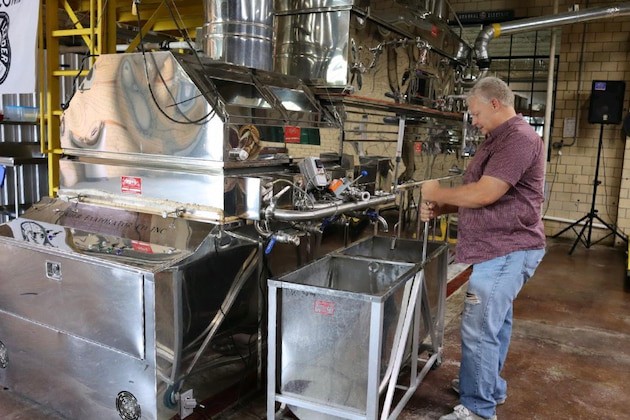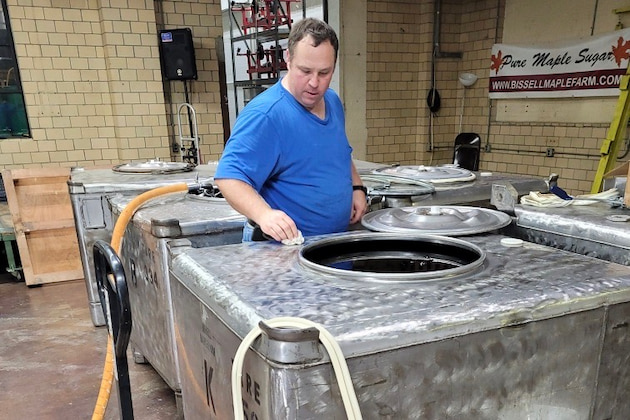Headlines
Maplestitskin! Ohio sugarmaker turns bad syrup into not-so-bad syrup
By PAUL POST | OCTOBER 29, 2021
JEFFERSON, Ohio—Call him Maplestiltskin.
Sugarmaker Nate Bissell is the self-proclaimed Rumpelstiltskin of the maple industry.
Somewhat like the Brothers Grimm fairy tale imp, who spun straw into gold, Bissell in September turned a large supply of off-flavor, fermented syrup into a marketable product.
"We called the project Maplestiltskin," said this sixth-generation producer of Bissell Maple Farm in Ashtabula County, Ohio.
"Food companies (including well-known cereal brands) want cleaner labels with fewer ingredients,” he said. "They buy commercial syrup all the time. This market wants a maple syrup that will have a strong flavor, sweeten and add some color and texture. Most people don't even know it exists. That's what this is for."
"Would I put this on my pancakes? Heck no!" he said. "It's not going to be table grade that would win an award. But it would be great in granola. I know of a sausage company that buys $1 million dollars of commercial syrup per year. It's going into sausage, ham and bacon."
So in early September, six months after the traditional sugaring season, Bissell's evaporator was churning out 100 gallons of syrup per hour, providing a welcome financial boost to his annual revenue stream.
Bissell purchased 35,000 pounds of fermented syrup, which had been stored in plastic drums.
"I bought it all for a dollar per pound," he said. "It used to be good syrup, but it spoiled. The integrity of a plastic barrel is very poor. Even though it holds liquid, maple syrup will not keep because oxygen will permeate plastic."
He learned about the supply from industry sources.
"A lot of fermentation had occurred and there was a lot of carbon dioxide, so it was very foamy," Bissell said. "It was a risk, but I had previously done some small pilot tests, experimenting with a few drums of different farmers' syrup that had spoiled. This is a common issue. It's common with drums that aren't quite full and very common in plastic. It happens to almost every farmer."
Reprocessing and freight cost another $4,000 and he lost about 1,000 pounds during boiling, but still wound up with 3,100 gallons of marketable product, more than double the roughly 2,000 gallons of prime grade syrup he makes in a normal year.
He's an "open book" when it comes to sharing processing details.
"Here's why it was successful," Bissell said. "Number one, there was enough volume to run a large production. I need 250 to 300 gallons of sap just to fill my evaporator. So if you're going to try to 'fix' one drum it isn't economical. It's too difficult."
The syrup he purchased had no quality or grade.
"Not all of the syrup was 66 brix," he said. "Some had fermented and dropped down to 62 brix. By diluting it back down with permeate I was able to boil it again. I basically made sap. I reverse-engineered sap. Instead of having an RO (reverse osmosis) where I would take sap up to 15 brix, I took a bunch of spoiled syrup and diluted it down to 15 brix."
His formula was one gallon of syrup and three parts water.
After filling bulk sap tanks halfway with water, he pumped spoiled syrup into the tanks and added more water to finish.
He put the water in first or syrup would have stayed at the bottom.
"When you put dense liquid into thinner liquid it will dissipate as opposed to protecting itself from the thinner liquid," he explained.
"Then I ran a pump and circulated it to mix it completely because I really wanted to know what my brix were when I started," Bissell said. "Then I added permeate. That's important. I didn't want to add minerals. You want to keep the integrity of the syrup. When adding permeate you aren't adding minerals."
His production facility is housed in a 40,000 square foot, former General Electric Company plant in Jefferson, Ohio. He admits being nervous at first, unsure how his expensive evaporator would handle the process.
"I had the defoamer ready, I thought I was going to have a science project," Bissell said. "But it went incredibly well. There was no niter buildup. I didn't have to add hardly any defoamer. The flavor improved drastically."
Bissell Maple Farm has three different commercial grades of syrup, which he described.
With C1, only a good producer could tell there's some off flavor.
"C2 we wouldn't give to any of our friends and family," he said. "C3, which we call 'mersh,' is spit-it-out grade."
"This went from C3 to C1," Bissell said. "We took it from the lowest, where you wouldn't normally buy it, to something that has a market value. It's definitely a better product. It still doesn't have the value of prime grade syrup. I can't stress that enough. It's for a commercial industrial market, which is pretty sizable."
He encouraged other producers to give the process a try, but of course there's no magic formula and there might be considerable trial-and-error before achieving desired results.
"I once heard that a maple farmer doesn't have 40 years of experience, they have one year of experience, 40 times," Bissell said. "It's different and new every year. At the end of every maple season I tell myself everything I'm going to do, so I'll be ready before the next season. Then I forget half of what I told myself I was going to do."
In addition to a financial boost, one of "Maplestiltskin's" side benefits is that all of Bissell Maple Farm's equipment is ready for 2022 because its sugarhouse was working overtime in September, while evaporators elsewhere sat idle.
"I've got it prepped and ready," Bissell said. "It forced me to basically have an extra maple season. It was about the easiest run of syrup I've ever done. We didn't quite turn straw into gold, but we tried."


































